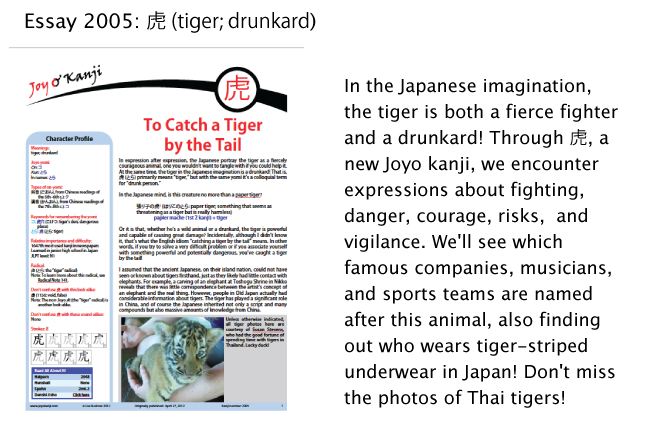The Root of the Matter
Someone wrote to me last week and mentioned the non-Joyo 鼠 (ねずみ: mouse). I'll enlarge it so that you have a prayer of seeing it:
鼠
A mortar jumped out at me! That is, although I had seen 鼠 several times before, I had never noticed that the top part is exactly like 臼 (mortar). Because I've been finalizing essay 1987 on 臼, which posts next week, I immediately spotted the 臼 in 鼠 this time.
I wondered, could the top of 鼠 represent the mouth of a mouse? After all, Henshall says the original 臼 probably symbolized a mouth with grinding teeth. And as we can see in one specialized dental term for "molar" (臼歯, きゅうし or うすば), molars are little mortars that grind food! I hoped the 臼 in 鼠 had some connection to the mouth, making 鼠 the Japanese version of Boca Raton!
Ah, in researching the etymology, I've found that 鼠 most likely has no connection to 臼. Any resemblance (and what an uncanny resemblance it is!) is probably just coincidental.
The truth is simpler: 鼠 is simply the pictograph of a mouse. What's more, 鼠 is a radical! I had no idea! This shape doesn't play a part in any Joyo kanji, but let's not overlook it entirely. For instance, it's the on-duty radical in this fun kanji:
鼬 (いたち: ermine, skunk, weasel)
There's a mouse inside an ermine, skunk, and weasel! I love when one animal lives inside another in the kanji world! I also find it amusing and fascinating that one kanji can represent multiple animals!
In another non-Joyo character, 鼠 is merely a component, whereas the 髟 radical is on duty:
This bit of insanity means "mane"!
Speaking of insanity, you may be wondering where I'm heading with this stream-of-consciousness exploration! Yes, good question.
Thus far I've mentioned three radicals:
臼 (Radical 134, the "mortar" radical)
髟 (Radical 190, the "long hair" radical)
鼠 (Radical 208, the "rat" radical)
The numbers are inessential, as are the names. I also don't feel that it's terribly important to know whether a shape serves as the on-duty radical in a character or whether it's merely a component along for the ride. (If you don't know what those expressions mean, check the first section of Radical Terms.)
The important thing about 臼, 髟, and 鼠, as with every other radical, is that they give us ways to see characters more clearly. Knowing 臼 gave me an entry point into the tangle of lines that constitute 鼠 (even though 臼 turned out not to be part of 鼠 etymologically). I can't say enough about how helpful it's been over the years to perceive the discrete components of characters, enabling me to resolve a messy network of lines into a few clean sections, figuratively speaking.
I was therefore distressed to see two cocksure comments to the contrary in recent online discussions. In both cases, a kanji learner asked whether there's any value in studying radicals as a way to learn kanji. And each time, someone declared with complete confidence that there's no value. I can't remember exactly what the first guy said, but I think he deemed it a waste of time to focus on radicals at all. In the second case, a native speaker asserted that although Japanese people know all the radicals and their names, it's pointless for nonnatives to do so.
These answers miss a lot.
They address complex issues dismissively with sweeping generalizations. That's annoying, no matter what the topic is! The comments also assume that we all learn and think the same way. We don't.
Most of all, these responses entirely overlook the benefits of being familiiar with radicals. For instance, I have found it incredibly helpful to know 爪 (nail) as a radical. (Essay 2071 on 爪 will post after 臼, so I have 爪 on the brain, too.) As a radical, 爪 is a shape shifter. That is, it has three variants (see the sixth section of Radical Terms for an explanation). In that way, it becomes almost unrecognizable inside other kanji, such as these:
受 (303: to accept), in which 爪 is a mere component
争 (529: to argue), in which 爪 is the on-duty radical
It's impossible to spot 爪 in kanji 529, isn't it? That's because 爪 was in the old form of 争, which was 爭. Even though we can no longer see 爪 in the modern form, it remains the on-duty radical. Tricky!
Without knowing that 爪 exists as an entity, I would have a hard time locating 妥 (1538: to come to terms) in Denshi Jisho. I might end up scanning the array of 171 kanji with the "woman" radical, 女, feeling more frustrated each second:

By contrast, selecting the 爪 and 女 components in Denshi Jisho narrows the search results to just five, with 妥 coming first:

Similarly, if I didn't know 爪, I would struggle when looking up 将 (899: general officer). In this case, two components are unrecognizable—not just 爪 but also the shape on the left. That one is a variant of 爿(Radical 90, the "split wood (left half)" radical), so knowledge of radicals pays off twice here.
My in-depth exploration of 虎 (2005: tiger), which came out today, prompted me to write Radical Note 141 on the "tiger" radical. By learning about that radical, 虍, I wasn't overwhelmed when I recently encountered 慮 (1904: concern, thought). Rather, I could perceive this dense concoction as consisting of just two parts: 虍 and 思. How soothing that is! Life is sometimes simpler than it seems (which doesn't excuse those who oversimplify things with thoughtless comments!).
In the end, then, what is the value of a radical? Is it something akin to this:
枝葉 (しよう or えだは: branches and leaves; minor details)
What a wonderful word, by the way! Whereas English speakers might rough out a draft, later dotting every i and crossing each t, the Japanese focus on the trunk of a tree, leaving the branches and leaves to another time.
I think a radical is at the root of this metaphorical tree. After all, "radical" comes from a Latin word that means "having roots." Radicals are at the root of the matter.

Photo Credit: Yoshikazu Kunugi
Ancient Japanese cedars at Togakushi Shrine in Nagano Prefecture.
Well, if a radical is that important, should it be a source of shame if we don't know the radical of a particular character?
Oh, speaking of that, I recently stumbled upon this great expression:
穴があったら入りたい (あながあったらはいりたい: (to be ashamed enough) to wish you could just disappear)
A sample sentence:
こんなへまをして、穴があったら入りたいよ。
I've botched things up so badly I wish I could find a hole to climb into.
へま (blunder, gaffe)
I certainly hope this statement isn't about kanji! There's no shame in not knowing something kanji-related. It's a long journey, and it's all fascinating. Take your time to smell the radicals and everything else, never judging yourself for occasional slip-ups. Those mistakes are as much a part of the kanji landscape as ramen shops and train stations are in Japan.
Radicals are look-up tools. They're clues to etymology. And most of all they give us a way to break down characters.
Should we then memorize the chart of 214 historical radicals and drill it into our heads which radical is on duty in each kanji? No, absolutely not! There's no reason to treat kanji study as hard labor or even torture, as so many people seem to do!
If I want to get a handle on a particular radical, I simply look at the characters in which it appears. That's what I hope to accomplish with the library of Radical Notes that I'm slowly building. Along the way, I have immense amounts of fun, as with Radical Note 141 on the "tiger" radical. How could I not, with all those great photos of tigers?!
Life can be punishing enough. Exploring kanji doesn't need to be that way, too! Enjoy all that it has to offer. And enjoy your weekend (as well as Golden Week, if you're in Japan)! I hope you can find a way to let tigers into your life with Essay 2005. Here's a preview:


Comments